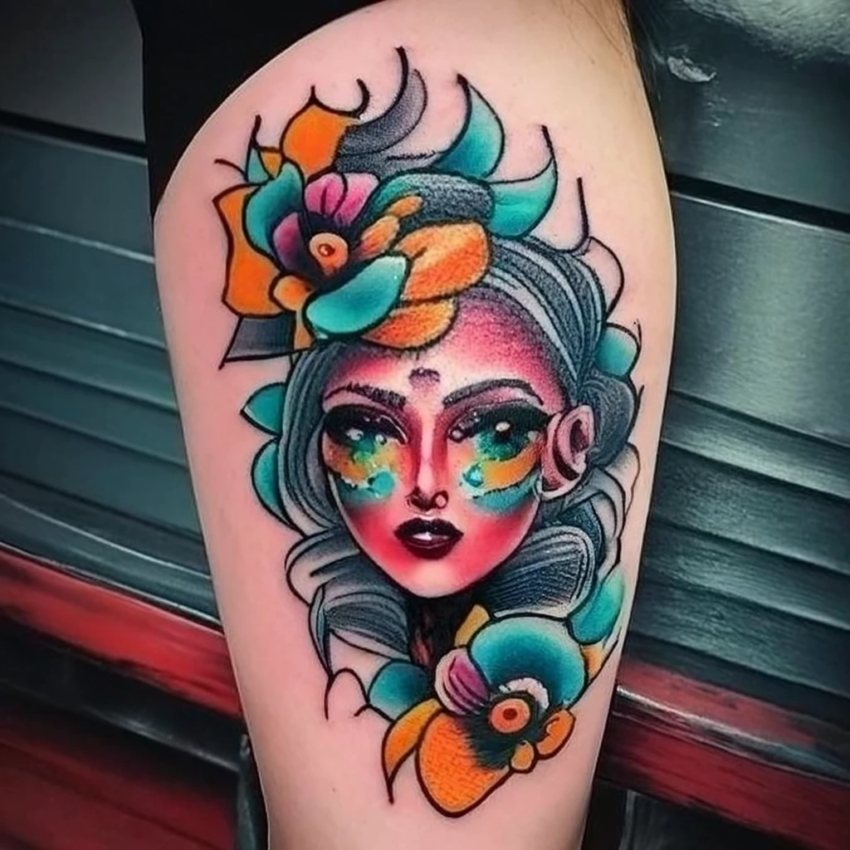Discovering the perfect time of year for getting a tattoo is an essential consideration that often goes unnoticed. Whether you’re a first-time tattoo enthusiast or an experienced ink lover, understanding the impact of different seasons on tattoo aftercare and healing can make all the difference in achieving stunning, long-lasting body art. From coping with scorching summers to braving the chill of winters, we’ve got you covered with expert advice to ensure your tattoo stays vibrant and healthy for years to come.
Understanding the Tattoo Healing Process
Getting a tattoo is not only an artistic expression but also a commitment to proper aftercare and healing. To ensure your tattoo looks its best and remains vibrant for years, understanding the tattoo healing process is crucial. This process can be divided into three key stages: immediate aftercare, initial healing, and subsequent healing.
Immediate Aftercare (First Few Hours)
During the immediate aftercare phase, your tattoo artist will provide you with essential instructions to follow. These instructions typically involve keeping the tattooed area clean and protected. It is vital to avoid touching the tattoo with dirty hands and to gently wash it with mild, fragrance-free soap. Your artist may recommend applying a thin layer of ointment and covering the tattoo with a clean, non-stick bandage for the first few hours.
Initial Healing (First Week)
As your tattoo enters the initial healing stage, you may notice slight scabbing and peeling. This is a natural part of the healing process as your skin regenerates. Resist the temptation to pick at the scabs, as this can lead to scarring and faded colors. Keep your skin moisturized with a tattoo-friendly lotion, and avoid soaking the tattoo in water, such as in hot tubs or swimming pools, during this time.
Subsequent Healing (Up to Four Weeks)
The final stage of the tattoo healing process can last up to four weeks. By this time, your tattoo should have shed most of its scabs and be well on its way to looking fully healed. Continue to moisturize the area regularly to prevent excessive dryness and flaking. During this period, your tattoo may still be sensitive, so avoid exposing it to direct sunlight or harsh chemicals.
Factors Affecting Tattoo Healing
Various factors can influence the healing process of your tattoo, making it essential to consider these elements when deciding on the best time of year to get inked. Let’s explore the key factors that can impact the healing duration and overall outcome of your tattoo.
The Impact of Chosen Body Placement
Where you decide to place your tattoo plays a vital role in its healing time. Areas with more muscle and flesh, such as the biceps or thighs, tend to heal faster due to better blood circulation. Conversely, tattoos on bony areas like the ankles or ribs may take longer to heal as they have less cushioning and blood flow.
Size and Intricacy of the Tattoo
The size and intricacy of your tattoo design also influence the healing process. Larger tattoos and those with intricate details may require more time to heal fully. The healing period for a small, simple tattoo might be quicker compared to a larger, more elaborate design.
The Artist’s Technique and Equipment
The skill of your tattoo artist and the quality of their equipment can significantly impact healing. A professional artist using modern, sterilized equipment is more likely to create a clean and precise tattoo, reducing the risk of complications during the healing process.
Tattoo Aftercare Tips for Each Season
To ensure your tattoo heals flawlessly, proper aftercare is essential, regardless of the season. Let’s explore the specific aftercare tips tailored to each season, ensuring your tattoo remains vibrant and healthy all year round.
Summer Tattoo Aftercare
Shield from the Sun: Protect your new tattoo from direct sunlight, as UV rays can fade colors and damage healing skin. Opt for loose-fitting clothing that covers the tattooed area or apply a high SPF sunblock before heading outside.
Avoid Water Exposure: Swimming and excessive sweating can disrupt the healing process during summer. Refrain from immersing your tattoo in water until it has fully healed.
Winter Tattoo Aftercare
Maintain Hydration: Combat the dryness of winter by regularly moisturizing your tattooed skin with a tattoo-friendly lotion. Well-hydrated skin promotes proper healing.
Mindful Clothing Choices: When dressing warmly, choose soft fabrics to avoid rubbing or irritation against your healing tattoo. Comfortable clothing ensures a smooth healing experience.
Spring and Fall Tattoo Aftercare
General Aftercare Tips: During these mild seasons, follow standard aftercare guidelines. Keep the tattoo clean, moisturized, and protected from excessive friction.
Allergen Awareness: Spring brings pollen and other allergens, which can irritate your healing tattoo. Be cautious and avoid unnecessary exposure to potential irritants.
A Year-Round Commitment
Regardless of the season, maintaining proper aftercare is a year-round commitment. Regularly moisturize your tattooed skin and avoid scratching or picking at scabs. Remember to consult your tattoo artist if you have any concerns or experience unusual healing symptoms.
Additional Aftercare Recommendations
Proper aftercare is the cornerstone of a successful tattoo healing journey. Beyond the seasonal considerations, there are essential aftercare practices that apply regardless of the time of year. Let’s explore some additional recommendations to ensure your tattoo heals beautifully and remains a source of pride.
Tips for Maintaining Proper Hygiene
Clean with Care: Gently wash your tattoo with mild, fragrance-free soap and warm water. Avoid using harsh cleansers or scrubbing vigorously, as this can hinder the healing process.
Pat Dry: After washing, pat your tattoo dry with a clean, soft towel. Refrain from rubbing, which can irritate the delicate skin.
Dietary Considerations for Healing
Stay Hydrated: Drink an ample amount of water to keep your body and skin hydrated, supporting the healing process.
Nutritious Diet: Consume a well-balanced diet rich in vitamins and nutrients, as this aids in skin regeneration and overall healing.
Following the Artist’s Aftercare Instructions
Listen to the Expert: Your tattoo artist will provide you with specific aftercare instructions tailored to your tattoo. Follow these guidelines diligently for the best results.
Avoid Over-Application of Ointment: While ointment helps keep the tattoo moisturized, applying too much can suffocate the skin. Apply a thin layer as advised by your artist.
Consulting a Professional
Recognize Healing Complications: If you experience persistent redness, extreme pain, or signs of infection, seek professional advice promptly.
Expert Opinion: Your tattoo artist or a dermatologist can offer guidance and solutions if any issues arise during the healing process.
Final Thoughts
The best time of year to get a tattoo significantly impacts aftercare and healing. Each season presents unique challenges and care requirements. By following proper aftercare practices, you can ensure your tattoo remains vibrant and meaningful for years to come. Embrace the commitment to aftercare, and your tattoo will become a lasting symbol of self-expression.
Frequently Asked Questions (FAQ)
Does getting a tattoo during a specific season affect the longevity of the ink’s color?
The season you choose to get a tattoo can influence the longevity of its colors. Tattoos exposed to excessive sunlight, particularly during summer, may experience fading over time. Proper sun protection and aftercare are essential to preserve your tattoo’s vibrancy.
Are there any specific precautions to take for tattoo aftercare in regions with extreme climates, such as deserts or humid tropical areas?
In extreme climates, such as deserts or humid tropical areas, tattoo aftercare becomes even more critical. Stay vigilant about keeping your tattoo moisturized and protected from excessive sun exposure or moisture. Following aftercare instructions diligently will help your tattoo heal optimally.
How does the healing process of tattoos on different body parts, like hands or feet, differ from tattoos on more common locations like the arms or back?
The healing process can vary based on tattoo placement. Tattoos on hands and feet may experience more friction due to constant movement, requiring extra care to avoid irritation. Tattoos on areas with more muscle and flesh, like arms or back, may heal faster due to better blood circulation.
Can wearing certain types of clothing, such as tight fabrics or rough textures, hinder the healing process of a tattoo?
Wearing tight fabrics or rough textures directly over a healing tattoo can cause friction and discomfort, potentially delaying the healing process. Opt for loose and soft clothing to ensure the tattooed area remains undisturbed during healing.
Are there any natural remedies or topical treatments that can help soothe tattoo irritation and promote faster healing?
While aftercare products recommended by your tattoo artist are ideal, natural remedies like aloe vera gel or coconut oil may provide soothing effects. However, always consult your tattoo artist before using any alternative treatments to ensure they are safe for your tattoo.

